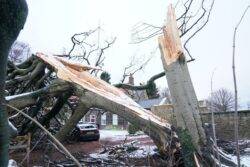Storm Arwen wreaked havoc in November 2021 (Picture: PA)
The compensation cap for households and businesses that lose power in severe weather is set to increase after the chaos of Storm Arwen left thousands without power for days.
Ofgem’s new rules follow their review into the response to the November 2021 storm, by distribution network operators (DNOs) – the companies responsible for linking homes and businesses to the electricity network in Great Britain.
The regulator said ‘lessons had been learnt’ following the inquiry, although Akshay Kaul, Ofgem’s director general of infrastructure said it was ‘unacceptable’ that thousands were left in freezing conditions in the wake of the storm, with no idea as to when their power might be restored.
‘Lessons have been learnt by the industry following our review into Storm Arwen, but the frequency of extreme weather events is only set to increase, so we need to make sure network services are resilient,’ Mr Kaul said.
Just what are the new rules – and what will the compensation cap increase to?
Here’s all you need to know…
How much is the new compensation cap for severe weather?
The compensation cap has increased from £700 to £2,000, in the event that households and businesses are left without power in a severe storm such as Arwen.
Under Ofgem’s new rules, the initial payment will also increase, from £70 to £80, if a customer’s supply is not restored after 24 hours in a category one storm or 48 hours in a category two storm.
Ofgem has also cut the length of the time consumers have to wait for additional compensation from 12 hours to six hours after the initial payment period.
Many were left without power for days due to storm damage (Picture: PA)
In the case of both storm categories customers are entitled to a further £40 for every six hours they are without power after the initial 24-hour or 48-hour period.
The new regulations will also allow for all compensation payments to be made by bank transfer so that the money will be received more quickly – while a new adjustment mechanism will allow these to remain in line with inflation.
Network companies that do not follow the rules could face multi-million pound fines.
How is a storm categorised?
A storm is categorised based on its impact on the electricity grid.
A Category 1 storm is regarded as one which causes between eight and 12 times the daily average number of faults within a 24-hour period.
A category 2 storm is one which causes more than 12 times the daily average number of faults.
Storm Arwen, which battered the UK with 100mph winds, left nearly one million homes and businesses without power in November 2021.
Around 40,000 customers were cut off for three days while around 4,000 had no power for over a week, in some parts of northern England and north-east Scotland.
Follow Metro across our social channels, on Facebook, Twitter and Instagram
Share your views in the comments below
The changes come after an inquiry into 2021’s Storm Arwen which left thousands without power for days.





